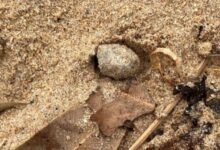Most Prominent Historical Landmarks in Hadramout

SMA NEWS – MUKALLA
The governorate of Hadramout obtain historical landmarks characterized by their unique architecture and marvelous geometric neatness. Some of them date back to ancient time which constituted the architectural historical identity of the biggest governorates of South Yemen although some of them have been subjected to neglect.
In some cities of Hadramout Coast, especially Hadramout’s capital city of Mukalla as well as the two historical cities of As-Shihr and Ghayl Ba Wazir In the east of Mukalla, there are palaces and landmarks that provide a unique picture of the major cities in Hadramout.
The establishment of the current historical places in Hadramout Coast, particularly in As-Shihr, Mukalla and Ghayl Ba Wazir go back to the reigns of Sultanates and states in South Yemen. This includes for example the Qu’aiti Sultanate, the Awlaqi Sultanate and the Buraiki Sultanate.
In the city of As-Shihr, there are important historical palaces, top of which are Dar Nasser Palace which was built by Prince Nasser Bin Naji Al-Buraiki during the reign of the Al-Buraiki State in the end of the 18th Century. Moreover, the same district contains Bin Ayash Fort which was built by Abdullah Bin Omar Al-Qu’aiti during the era of the Qu’aiti State.
The Palace of Sultan Ghaleb Al-Qu’aiti [the Mukalla Museum today] was built in 1925 in the main entrance of the city of Mukalla that was known as “Bar’ Al Saddah ”. The establishment of this palace was based upon the eastern Indian architecture style which affected many Sultans of the Qu’aiti State at this time.
After the downfall of the Qu’aiti Sultanate in 1967, the palace was dubbed “October 14th Palace”. In recent years, the palace was completely transformed to a museum which consists of three suites.
Al-Ghwayzi Fort at the Northern eastern entrance of Mukalla is considered one of the most prominent and important ancient sites in the city. It is an architectural masterwork built of mud mixed with straw and traditional materials on a curved rocky slope.
According to historians, the fort is known for its strategic site whose aim was to defend the city against any attacks that targeted Mukalla on the Arabian Sea coast. The fort dates back to 1716 during the reign of the Kasadian Sultanate of Mukalla.
Al-Bagh Palace is located in the west of the city of Ghayl Ba Wazir east of Mukalla. It was built by Sultan Omar Bin Awad Al-Qu’aiti in the last decade of the 19th Century.
Al-Bagh Palace has similarities with the Sultan Al-Qu’aiti Palace in Mukalla and Sultan Abdulkarim Fadl Palace in Al-Hawtah which is located in Lahj in South Yemen. Moreover, there are other palaces whose construction is inspired by Indian architecture.
The palace consists of two storeys with many rooms. It was constructed within a very beautiful garden which previously included various trees, some of which were brought from India.
Al-Awaliq Fort is located in the Al-Hazm Village in the Sadda area, east of Ghayl Ba Wazir. It was established on a geometrically high land. Its area is about 400 x 250 meters and consists of five high storeys.
According to experts, the fort was built in the mid of the 19th Century by Prince Abdullah Bin Ali Al-Awlaki who along with two other princes, Ghaleb bin Mohsin Al Kathiri, and Omar Bin Awad Al Qu’aiti, sought to establish a state in Hadramout during the British colonialism but they failed.
According to historians, the ships which passed through the Hadramout ports at that time took this fort as a guide.
The Middle School was a palace for Sultan Munasser Bin Ghaleb Al-Qu’aiti when it was built in 1890 in Ghayl Ba Wazir. In 1944, the palace was transformed to a public school under the name of “The Middle School”.
The school was the place where several prominent figures from Hadramout’s citizens graduated including the Southern leader Ali Salim Al-Bidh. The historical sources said it was then the only school in Hadramout before building several schools later. The school was recently transformed into a cultural center.
The Grand Mosque in As-Shihr, according to Historian Abdullah Haddad, is in the city of As-Shihr which is known as “the Grand Mosque” far east to Mukalla is the first mosque in Hadramout and South Yemen in general.
Al-Haddad said: “the mosque was built in the 16th Century after people of As-Shihr converted to Islam. They were among the Yemenis who became Muslims during the so-called the “Delegations Year”. The pillars of the mosque at that time were made of palm trunks, and its roof was made of the palm fronds”.
The Aidrous Gate which is known by the Hadramis as “(Sadat Al-Aidrous) is considered one of the most prominent historical sites in the city of As-Shihr, it was built during 1868-1888 ad. It constituted a unique example for the Islamic gates in Hadramout. It was named after Imam Sheikh Al-Aidrous to commemorate him and the nearby Al-Aidrous Mosque.
The Buraiki State Palace was built by As-Shihr Governor Nasser Bin Naji Bin Brik Al Yafei who constructed a palace for their state in the city of As-Shihr in 1768. During the reign of Al-Qu’aiti State, Sultan Abdullah Al-Qu’aiti Al-Yafei built two other stories in 1878 at a time when As-Shihr was the capital of Al-Qu’aiti State.
Tomb of the Seven Martyrs, As-Shihr people in Hadramout established the Tomb of the Seven Martyrs to commemorate the sacrifice made by 7 men in order to liberate their land during the Portuguese invasion.
Those martyrs motivated people against the Portuguese who invaded the city of As-Shihr in the 16th Century, specifically in 1523. Historian Haddad told “South24 Center”: “What were made by the Seven Martyrs and 700 others were considered a wonderful example for sacrificing for the nation and pride”.
south24.net








